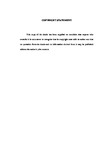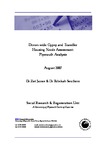Trace Metal and Speciation Analysis using Ion-Exchange and Energy Dispersive X-ray Fluorescence Spectrometry
| dc.contributor.supervisor | Foulkes, Michael, E. | |
| dc.contributor.author | Menendez-Alonso, Elena | |
| dc.contributor.other | Faculty of Science and Engineering | en_US |
| dc.date.accessioned | 2011-12-14T17:14:11Z | |
| dc.date.available | 2011-12-14T17:14:11Z | |
| dc.date.issued | 2000 | |
| dc.identifier | Not available | en_US |
| dc.identifier.uri | http://hdl.handle.net/10026.1/896 | |
| dc.description.abstract |
Studies have been carried out on specific ion-exchange (Dowex 50W-X8 and Dowex 1-X8) and chelation (Chelex-100) resins, in order to determine their physical and chemical characteristics, to understand and explain their limits of function and to optimise their use as substrates in trace metal and speciation measurement by EDXRF. Structural information was obtained by scanning electron microscopy and x-ray microanalysis showing a homogeneous distribution of functional groups and retained ions on both sectioned and whole resins. Particle size experiments performed on Dowex 50W-X8 (38 - 840 µm) showed that this parameter has no effect on the relationship between intensity of fluorescence and concentration or mass of resin. Inter-element effects were not observed in the analysis of multielemental specimens prepared on ion-exchange / chelation media by EDXRF. This indicates that the proposed method has a significant advantage when compared with other methodologies. A theoretical ‘model’, based on the formation of thin films on the surface of the resin beads, has been proposed in order to link and explain the effects observed in these experiments. The use of a batch retention system has shown distinct advantages over using columns in terms of linearity, accuracy, precision, rapidity and simplicity. Parameters such as pH and ionic strength of the solution, concentration of competing ions and volume of the sample have been proven to be critical. The maximum retention capacity has been determined as 3.2, 1.1 and 0.67 mEq/g for Dowex 50W-X8, Dowex 1-X8 and Chelex-100 respectively. The optimum mass of resin for XRF analysis was found to be 0.5 g, for all resins tested. The linear range covered 4 to 5 orders of magnitude. These findings show the potential of the investigated media to overcome instrumental and sample limitations. Based on the physico-chemical information found, methodologies for three different applications of the resins to EDXRF determinations have been developed and their analytical possibilities explored. The multi-elemental determination of metals in sewage sludge digests was achieved by retaining the metals on Dowex 50W-X8 at pH 2 and Chelex-100 at pH 4. Chelex-100 allows quantitative recoveries for Cu and Zn. A wider range of elements was determined on Dowex 50W-X8, although with poorer recoveries (60 - 90%). The limits of detection were 10 - 21 µg when Dowex 50W-X8 was used and 8 - 49 µg for Chelex-100. The method was validated by the analysis of a certified material. The determination of Kβ/Kα intensity ratios for Cr and Mn species and its potential as a tool for direct elemental speciation has also been studied. A difference in Kβ/Kα between the oxidation states of the analytes was only observed during the analysis of solutions of the metal species by EDXRF at the 98% level of confidence. Finally, the speciation and preconcentration of Cr(III) and Cr(VI) in waters has been performed by retention on Dowex 50W-X8 and Dowex 1-X8 followed by EDXRF determination. Efficient recoveries and preconcentration factors of up to 500 were achieved, leading to limits of detection of 30 µg/L for Cr(VI) and 40 µg/L for Cr(III). This method is simple, fast and inexpensive, allowing quantitative recoveries in the speciation of chromium in waste waters. | en_US |
| dc.language.iso | en | en_US |
| dc.publisher | University of Plymouth | en_US |
| dc.subject | X-ray Fluorescence Analysis | en_US |
| dc.subject | Multi-element analysis | en_US |
| dc.subject | Trace amounts | en_US |
| dc.subject | Trace metals | en_US |
| dc.subject | Speciation analysis | en_US |
| dc.subject | Chemical state | en_US |
| dc.subject | Scanning electron microscopy | en_US |
| dc.subject | Structural chemical analysis | en_US |
| dc.subject | Quantitative chemical analysis | en_US |
| dc.subject | Resins | en_US |
| dc.subject | Chromium | en_US |
| dc.subject | Manganese | en_US |
| dc.title | Trace Metal and Speciation Analysis using Ion-Exchange and Energy Dispersive X-ray Fluorescence Spectrometry | en_US |
| dc.type | Thesis | |
| dc.identifier.doi | http://dx.doi.org/10.24382/1549 |
Files in this item
This item appears in the following Collection(s)
-
01 Research Theses Main Collection
Research Theses Main



